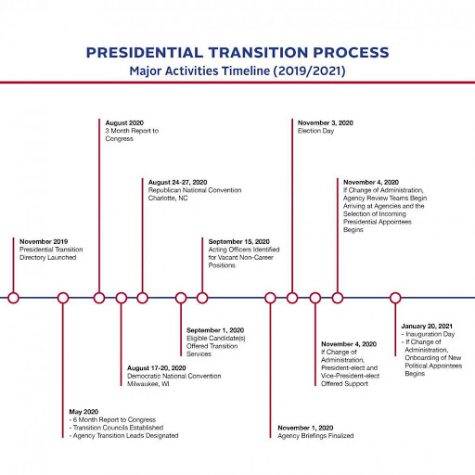The Process After the Presidential Election

As President of the United States, it’s not as easy as passing a baton to the next one. The Presidential Transition is a period in which the President-Elect of the United States installs and helps transfer the duties of the administration of the current President to that person. This process has massively evolved over time and has become a shorter period.
From the first transition between George Washington to John Adams, all the way to the one currently happening now between Donald Trump and Joe Biden, one that many argue to be quite controversial today. Transitions involve the transfer of not only the president but the Cabinet, which includes the Vice President of the United States, as well as the leaders of the 15 different Executive Departments, known all as the Secretaries of the departments with the exception of the Department of Justice, led by the Attorney General.
All of these positions have to be nominated by a President, but they cannot be confirmed until after Inauguration Day when the President-Elect is sworn in. Then the new President can officially nominate the candidates, which can then be confirmed by the United States Senate.
There are a few though that do not need to be confirmed by the US Senate, including the White House Staff. The staff is led by the White House Chief of Staff, who then directs most high-level staff and public relations for the President’s Administration. Notable positions include the Press Secretary, the Communications Director, the National Security Adviser, and more. The executive positions that the new administration will have to review and confirm is listed in the United States Government Policy and Supporting Positions booklet, also known as the “Plum Book.” This book has been created and published by the US Senate Committee on Governmental Affairs and the House of Representatives Committee on Government Reform.
The Transition lasts normally about two and a half months from just after Election Day on November 3rd to Inauguration Day on January 20th. For Congress, including both Representatives and Senators, the period is even shorter, as the inauguration for the new United States Congress occurs on January 3rd. This transition period was once longer, being on March 4th for both Congress and the Presidency. This was changed through the 20th Amendment of the US Constitution, ratified January 23, 1933, making the first term of Franklin Delano Roosevelt’s Presidency the last to be inaugurated on March 4th, 1933.
After Election Day, with a decided candidate that will replace the previous incumbent winning, The General Services Administration (GSA) begins fully implementing staff and positions for the transition, first beginning as early as September for major party candidates, as well as National Security briefings. The GSA is also one of the first government agencies to acknowledge the President-Elect before the Electoral College officially elects the next President and Vice President of the United States. The big transition will occur on Inauguration Day, and as the old President leaves the White House with the President-Elect headed towards the US Capitol, staff begins to rearrange the White House, such as the Oval Office and the Residence, into the President-Elect’s choice. The old staff officially leave and the new staff officially arrive and get right to work. This process all occurs in a matter of hours.

Not all transitions have been smooth as others. In 1974, when Richard Nixon announced on August 8th of that year that he would resign the next day, government officials scrambled in order to create a fast transition for Vice President Gerald Ford to become the 38th President of the United States. In 2000, George W. Bush did not officially win the election until December 12th of that year, shortening the transition period by over a month.
Disputes over the 2020 election are still occurring as Donald Trump has refused to concede the election to Joe Biden, who has the majority of electoral votes in the Electoral College. The transition, despite the surrounding controversy, is currently happening and the GSA has acknowledged Joe Biden as the President-Elect. The Electoral College will vote on December 14, 2020, officially announcing the next President and Vice President of the United States. Congress will receive those votes by December 23 and will officially count them on January 6th.

This transition is a matter of importance not just for a smooth transition of an administration to the next, but for a continuation of the US Government working and operating as if nothing happened, as so many aspects of government rely on this smooth transition in order to continue working and operating. Without a leader, there cannot be any direction for the staff and the multiple executive departments and agencies to operate. The transition period lasts forever as a mark to our resilience in a democracy and the continuation of our democratic ideals that all of us live by today, and for the future to come.

Edmond Kunath is returning to Nest Network for his third year, having previously worked with the Eagle Quill. Edmond is the Advertising Manager, and with...





